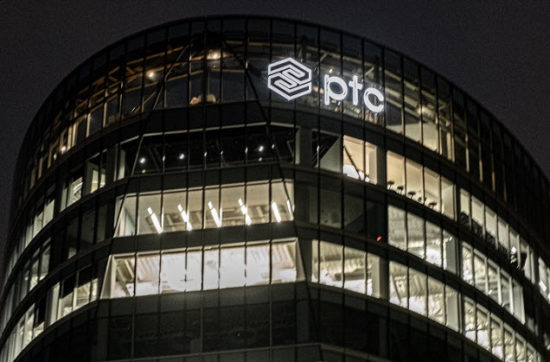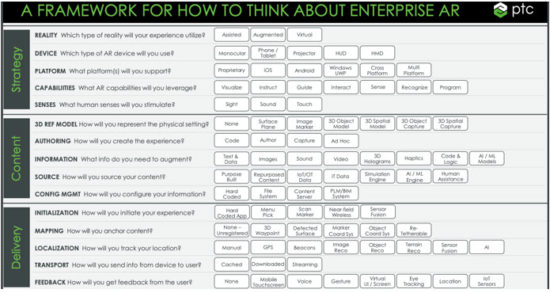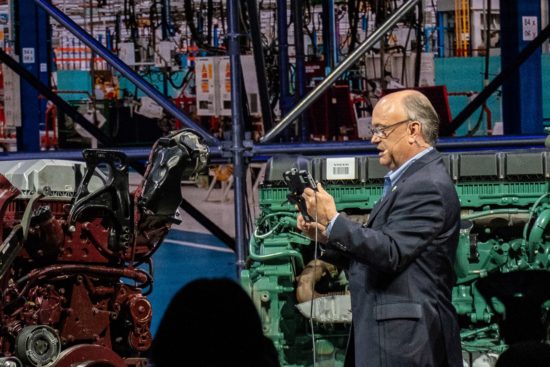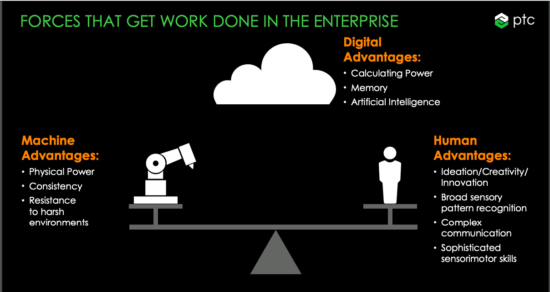The company that helps design and build things is putting them online; seeing 30–40% IoT growth.

PTC’s new headquarters on the Boston waterfront is in the heart of Boston’s building boom and designed to be a magnet for talent in PTC’s fast-growing IoT and AR business. (Source: JPR)
PTC is building on gains made and lessons learned. CEO Jim Heppelmann was a keynote speaker at the AWE AR conference in May and followed up a few weeks later with the company’s Liveworx conference, which supports the company’s growing IoT and AR businesses. Heppelmann’s mission at AWE was to give the audience a realistic guide to building AR apps. At Liveworx, he had something of the same agenda except that he was talking to an audience that was well aware of how difficult it can be to build IoT and AR into their workflows. The manufacturing industry is defined by huge amounts of information and over decades has developed a massive PLM market to manage and track information.
PTC’s Vuforia is cornerstone company for Augmented World Expo (AWE) and the company is well aware that while attendees are familiar with Vuforia, they may have no idea what PTC does and if they do what engineering software has to do with AR.
At AWE, Heppelmann presented a schematic to make people interested in building AR applications aware of all the variables they need to think about. How will people interact with your application, how will they know what to do, how will they make choices (do you want them to have choices?), what is the content you want to present, where is the content you want to present, how does your app access it, should the app know where the user is located, does the user need to navigate in space, interact it the real world, etc.

What’s your reality? AR doesn’t come in a box. Jim Heppelmann told the keynote audience at AWE to map out their desires and goals before launching an AR project. (Source: PTC)
He said that he is still surprised how little people really know about AR, how to put it to work and how to sustain the work.
At PTC Liveworx, he elaborated more the company’s work with customers. He said that when he first started talking to customers many of them said they were building their own. And he said, many early AR apps were built using Unity. Unity is easy for many people to use and it’s freely available, but notes Jim, a Unity app is basically code wrapped around content. If you want to change anything, you have to change the code. His mission these days is to educate people to the value of applications like Thingworx and Vuforia for building applications and templates for industrial AR.
At Liveworx, PTC showed a series of demos to walk the audience through the capabilities of PTC’s products Creo (design), Liveworx (IoT), Windchill (PLM), and Vuforia (AR). We’ve seen similar demos from PTC at Liveworx past, but this year the company was able to showcase customer use cases from Volvo and Howden and they highlighted automation partner Rockwell. Last year, Rockwell and PTC announced a strategic partnership for factory automation. This PTC has trained 1500 Rockwell employees to sell IoT and AR for Rockwell’s automation business, and also this year, the companies have been able to expand their deal with Ford from one plant to four. Heppelmann said the two companies find it very promising that the deals they’re closing are new deals are not with Rockwell’s current roster of clients but with they are new deals, and the companies are adding.
Transforming manufacturing
Manufacturing is being fundamentally changed by digital technologies and by customers. In the automotive industry, customization begins at the design phase as we’ve seen automotive manufacturers link and intertwine digital information with real-world data that stays with products from conceptualization to manufacturing to use and maintenance via the Internet of Things. PTC calls this relationship the digital thread, Siemens and Dassault talk about digital twins, but the idea is the same and at Liveworx and AWE, Jim Heppelmann wanted people to understand that “you can’t have IoT without the digital thread.”
He talked about how a venerable company like Howden, which sells industrial fans, compressors, heaters, and turbines has embraced digitalization to modernize its products and services. Working with PTC the company has added a layer of digitized information to their products that can be visualized via AR. They can enable their customers to better monitor the performance of the products, but Howden can differentiate itself in a very mature market.
In a demo with Volvo’s truck group, Heppelmann used two truck engines in his demonstration of enhanced truck maintenance and repair using AR. Representatives from Volvo said that they build 260,000 trucks a year and most of them are different. They are working with PTC to provide maintenance tools for their truck engines. They’ve used Vuforia to build an iPad app that enables customers to scan a barcode, which identifies the particular truck engine and is then able to provide an operator with a step by step procedure for maintenance using an AR overlay on the iPad.

What’s important about what PTC is doing is that they are building on the work of generations of CAD and PLM. Using the Volvo demo, Heppelman points out that the mobile devices being used for AR and IoT don’t have the local storage to maintain all the data for all the possible configurations of a truck engine. Instead, when the engine is identified, the application is able to assemble the necessary data from the information maintained in PLM and that’s the way it needs to be. The digital thread is always maintained and updated and is the single source of the truth.
Heppelmann says AR and IoT need PLM as badly as CAD does, but the flip side is even more true, IoT and AR enable people to see and interact with their data in meaningful ways that are only now becoming possible. After all, the things part of the IoT equation is ancient. Machines have been recording data about themselves via programmable logic controllers, PLCs, for a long time but the industry had to wait until digitalization and the cloud to form for that data to become accessible. Now the industry is working on making it meaningful.
Last year at Liveworx, PTC demonstrated Vuforia Expert Capture, an authoring tool that lets people record their motions as they work with machines. The system is being demonstrated with Microsoft’s Hololens and it was showcased at Liveworx with customers like GlobalFoundries. With this app, the company is addressing the issue of companies dealing with an aging workforce and also a boom driven dearth of trained replacements. Using a product like Expert Capture, new recruits can simply don the Hololens and get to work with instructions about their job being provided in the heads-up display.
Speaking to press and analysts, Heppelmann talked about how tools like this can transform education. Traditionally we’re all trained from high school on a just-in-case basis but AR can help enable training on a just-in-time (JIT) basis. Instead of having to learn about every possible eventuality of a situation, just-in-case, people can learn the tasks they need when they need them.
At AWE and at Liveworx Heppelmann said that AR is IoT for people but he added in a talk to press and analysts, I’m not saying that AR should be putting hands and feet on a machine or that people should stop learning.

So how is all this panning out?
Last year, it was reported in CRN that PTC’s AR business had reached $20 million and the company was experiencing 100% growth. This year, in the company’s financial call, Heppelmann noted that AR is continuing its steep growth curve “in the triple digits,” while the company’s IoT business, which includes AR, has been growing at 30-40%. For the second quarter, PTC reported $39 million in revenue for its IoT segment.
The company is also seeing new deals coming from its alliance with Microsoft. In the company’s quarterly call, he said, “we closed 35 deals, roughly tripled the deal count of Q1, and the active co-sell pipeline has grown to 240.”
Now that the Hololens 2 launched this year at the Mobile World Conference, PTC is expanding to see AR sales ramp as a result.
Heppelmann says that AR is turning into a very nice business for the company.
The challenges he’s seeing to further growth are the challenges that come with success and a growing economy. The company is finding it hard to grow its economy fast enough.
What’s not said, but we believe at JPR, is that nurturing new markets like IoT and AR is a pretty good way to protect against a future where the economy is not booming and mature markets settle back into slow growth.





